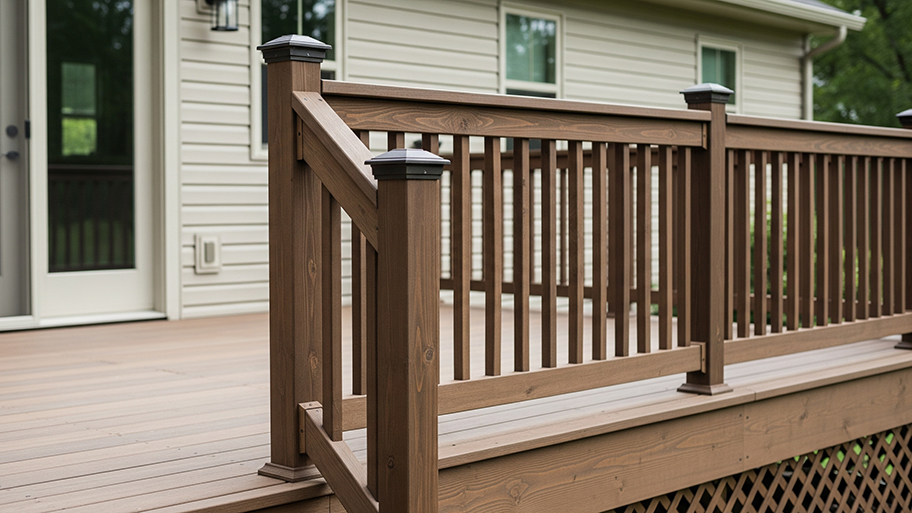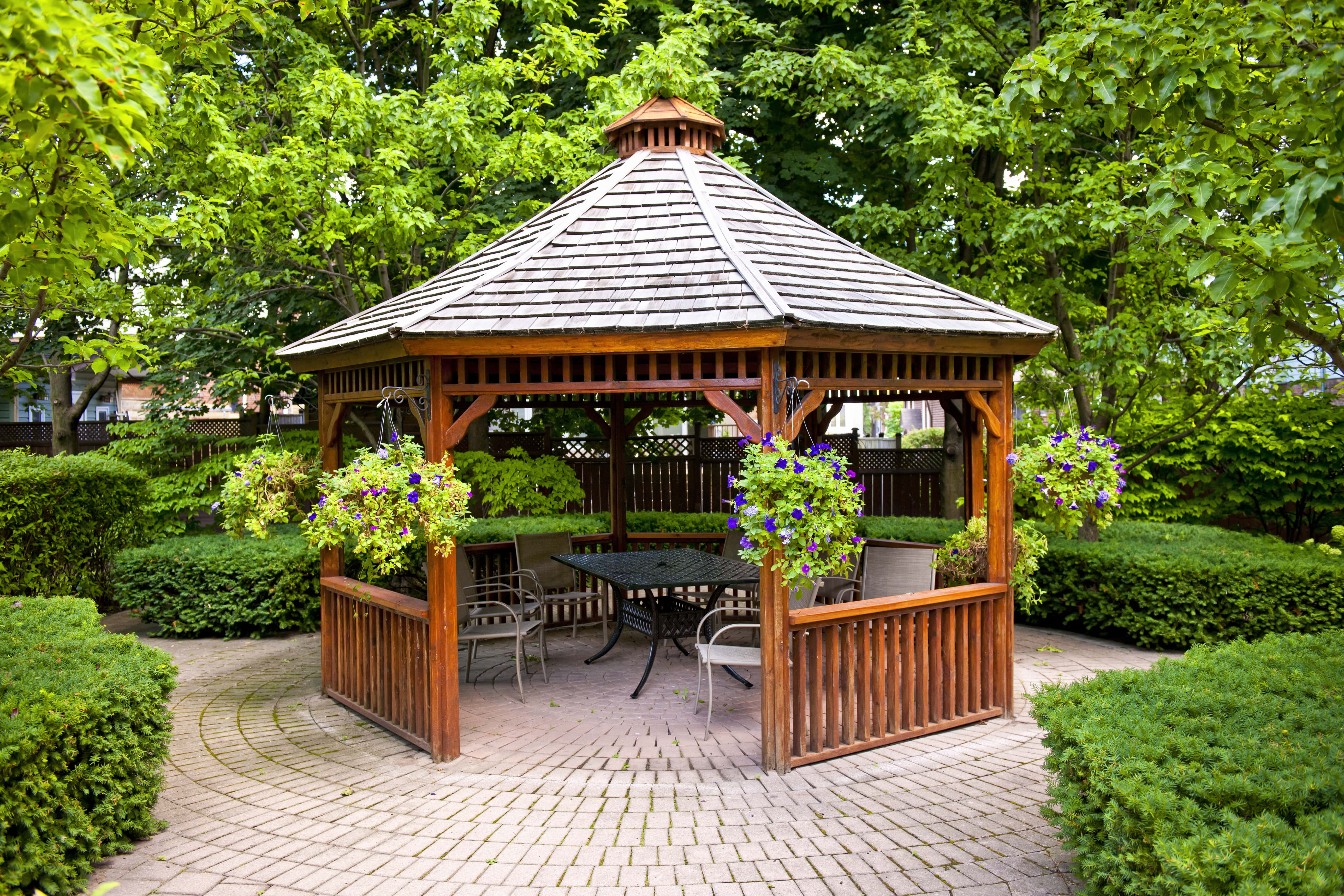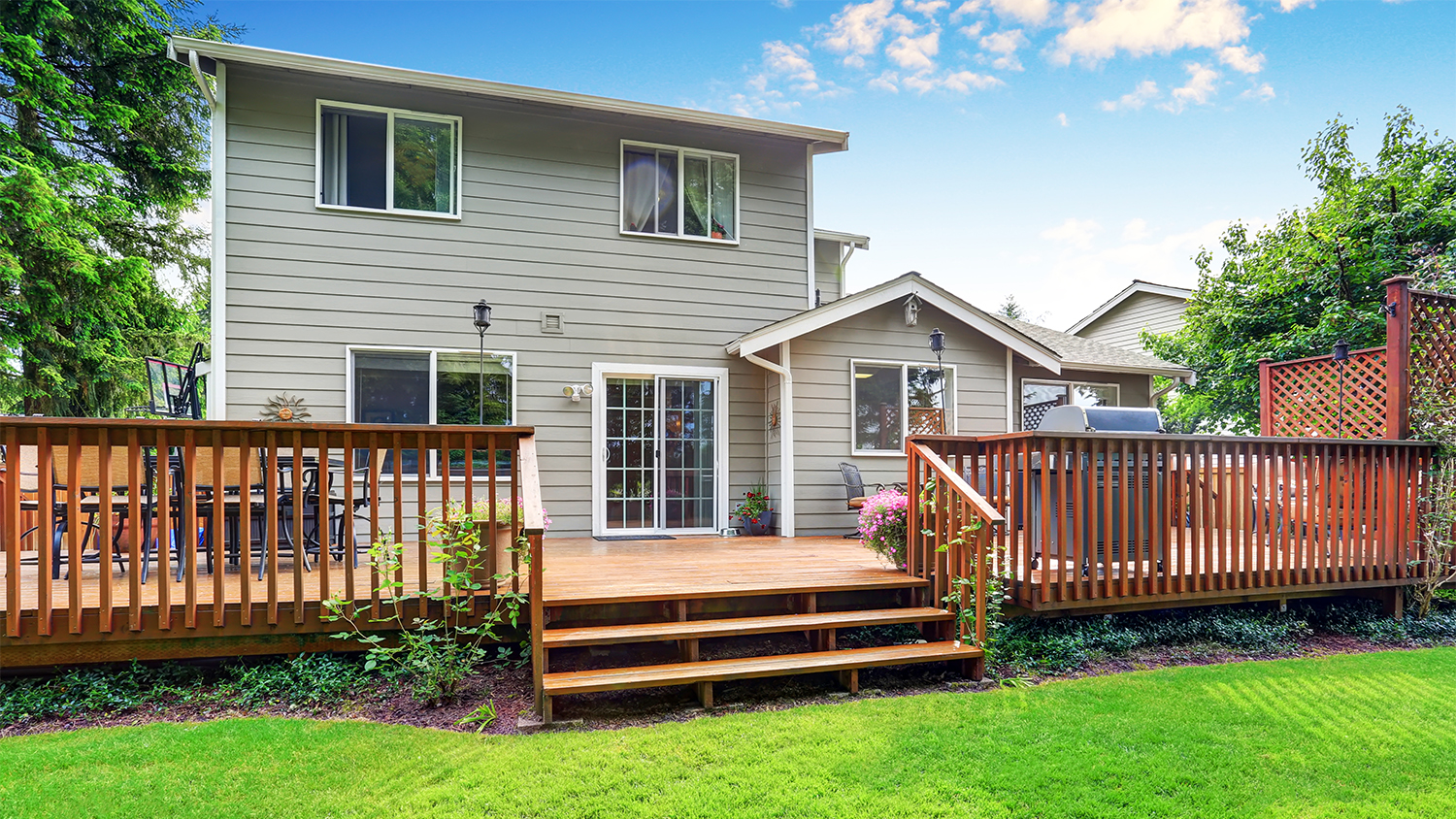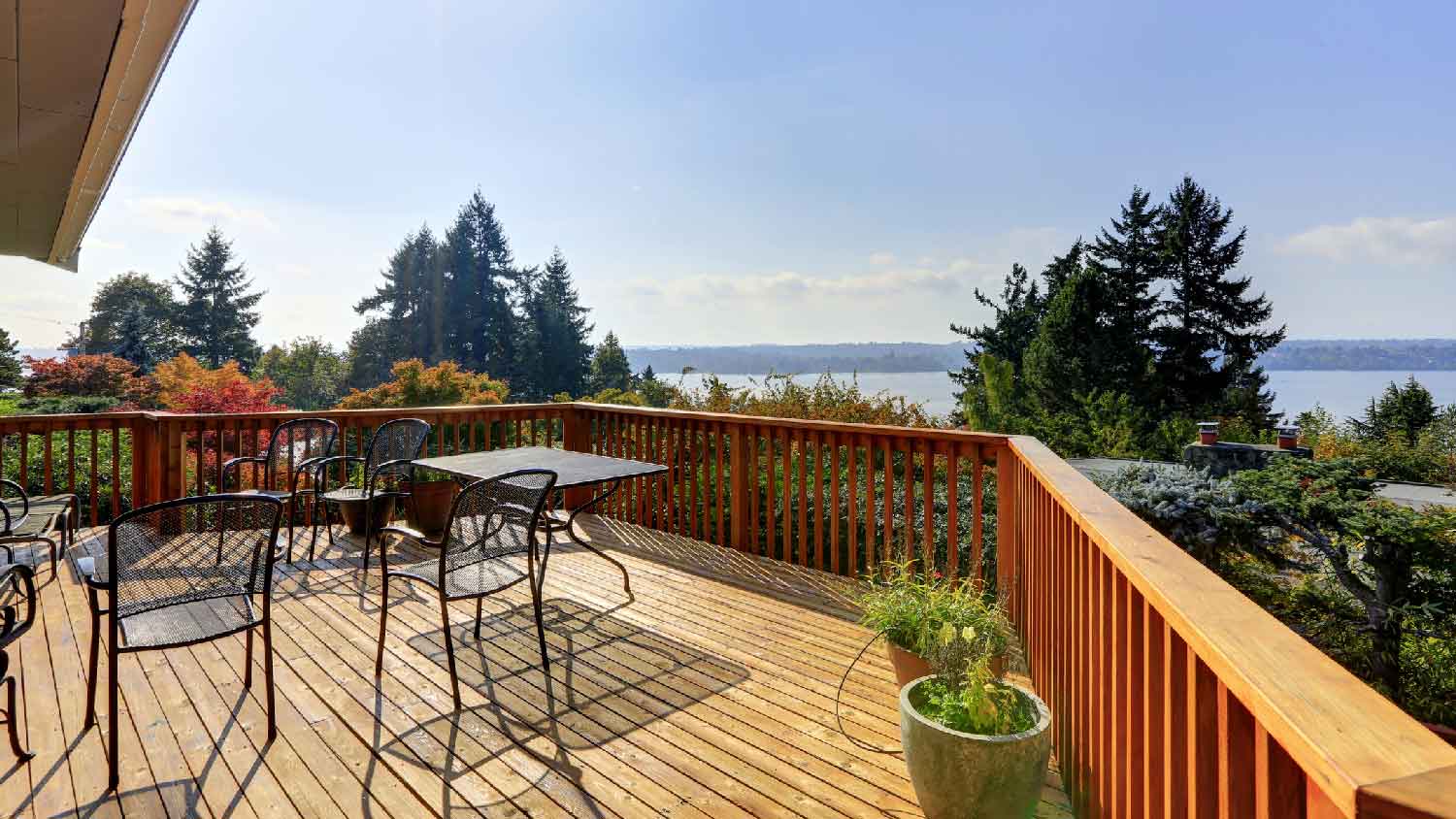
The average cost of a deck railing depends on size, type, material, and labor in your area. Check out this guide to determine what works for your budget.
Steel deck framing costs between $2,400 and $11,300 on average, with most homeowners paying $3,900. Your final price depends on deck size, material grade, labor, and added features.


Steel deck framing offers superior durability and fire resistance.
The main steel deck framing cost drivers are deck size, steel grade, and labor rates.
Expect to pay $20 to $40 per square foot, including labor and materials.
Professional installation costs $9 to $12 per square foot and ensures structural safety and code compliance.
Steel framing can increase home value and offers a 60% to 80% ROI.
This article was created using automation technology and thoroughly fact-checked and edited by an Angi Editor in accordance with our AI policy.
On average, steel deck framing costs between $2,400 and $11,300, with most projects averaging $3,900. Homeowners can expect to pay $20 to $40 per square foot, depending on deck size, steel type, and installation complexity. Understanding these costs helps you plan and budget for a safe, long-lasting deck.
Let’s look at what influences steel deck framing cost and how to make the best decision for your home and budget.
The size of your deck is the most significant factor in determining steel deck framing cost. As the total square footage increases, both material and labor expenses rise, with an average price range of $20 to $40 per square foot. Small decks require less steel and quicker installation, while medium and large decks need more framing, supports, and time.
Multi-level or uniquely shaped decks often involve additional engineering, which increases the price. Attached decks cost less to frame than freestanding versions due to fewer required supports and a simpler layout.
| Deck Size (Sq. Ft.) | Description | Average Cost |
|---|---|---|
| 100 | Small (balcony, entryway) | $2,000–$4,000 |
| 200 | Medium (standard backyard) | $4,000–$8,000 |
| 400 | Large (entertainment or multi-level) | $8,000–$16,000 |
| 700+ | Custom/extra-large | $14,000–$28,000+ |
Choosing the right steel deck framing type affects both the upfront cost and the long-term performance of your deck. Several systems are available, each with unique benefits and price points.
Galvanized steel is a common choice, offering solid corrosion resistance at a moderate price. Powder-coated steel costs more, but adds extra protection and color options. Modular steel framing kits can speed up installation and minimize waste. Light-gauge steel is less expensive and easier to handle, while heavy-gauge options offer greater strength for larger decks or commercial use. Hybrid systems integrate steel with other materials for unique projects.
| Framing Type | Description | Cost Impact | Pros | Cons |
|---|---|---|---|---|
| Galvanized steel | Zinc-coated for corrosion resistance | Moderate | Durable, widely available | Limited color choices |
| Powder-coated | Painted finish over galvanized steel | High | Superior corrosion protection, color options | Higher cost, possible chipping |
| Modular kits | Pre-engineered, ready-to-install sections | Moderate–high | Fast installation, less waste | Limited design flexibility |
| Light-gauge | Thin, lightweight steel framing | Low–moderate | Easier to cut and install | Lower load capacity |
| Heavy-gauge | Thicker, stronger steel framing | High | Supports larger spans, very strong | Heavier, more expensive |
| Hybrid systems | Combines steel with wood/composite | Moderate–high | Customizable, unique designs | Complex installation |
Where you live has a noticeable effect on steel deck framing cost. Material and labor prices tend to be higher in urban areas due to demand and transportation logistics. Rural locations may offer lower labor rates, but delivery fees for steel can add up.
Local climate also impacts the choice of steel finish—coastal or humid regions require stronger corrosion protection. Additionally, some areas have stricter building codes or inspection requirements, which can increase costs.
Several key factors influence the final cost of installing steel deck framing. Let’s break them down so you can plan for each part of the project.
Labor is a major part of steel deck framing costs. Most homeowners hire professional deck builders or steel framing specialists for this work.
Expect to pay $9 to $12 per square foot for labor alone. Complex designs, difficult site access, or high local demand can push rates higher. Urban areas and regions with higher wages will see the biggest increases.
Most steel deck framing projects require building permits. Permit fees range from $100 to $500, depending on your municipality and deck size. Your local building department may also require structural drawings and inspections, adding to the timeline and cost.
Contractors often handle permit applications, but it’s best to confirm before work begins. Allow two to four weeks for permit approval in most areas.
Upgrades and custom features can significantly increase steel deck framing cost. Adding stairs or deck railings may cost $1,000 to $4,000 extra, while multi-level platforms or built-in seating can add $2,000 or more.
Custom powder coating for the steel framing can cost $6 to $12 per square foot. Integrating lighting, drainage, or other built-in elements also increases labor and engineering expenses. The more complex the design, the higher the total price.
Other costs can sneak up during a steel deck framing project. Site preparation, such as clearing, grading, excavation, or removing an old deck, may add $500 to $3,000. Tight spaces, sloped lots, or difficult access can increase labor time and delivery fees.
Steel delivery fees can range from $100 to $500, especially in remote areas. After construction, debris removal and cleanup may add another $200 to $800. For custom-engineered decks, design and engineering fees could reach $500 to $3,000, and required inspections may have their own costs.
While the main project cost covers materials and installation, several ongoing or indirect costs factor into your total investment.
Steel deck framing components often come with manufacturer warranties ranging from 25 years to a lifetime, covering defects and corrosion. Contractors may offer workmanship warranties, often one to five years. Strong warranty coverage can reduce long-term repair costs, but may add a premium to your initial price.
Always review what’s included and excluded, as some warranties do not cover labor or damage from improper installation.
Steel framing is highly energy efficient, but you should consider thermal bridging—steel can conduct heat, potentially affecting adjacent structures. This is rarely significant for outdoor decks, but it’s worth discussing if your deck attaches to a climate-controlled area or is close to sensitive landscaping.
Steel deck framing needs much less maintenance than wood. Plan for annual inspections to check for rust or loose fasteners, and clean debris as needed. If scratches or exposed areas occur, touch them up with corrosion-resistant paint.
Comparatively, steel framing saves time and money over wood, which needs staining, sealing, and regular repairs. Expect to spend $50 to $200 per year on routine steel deck maintenance.
You’ll likely pay sales tax on both materials and labor, depending on your state or local regulations. Adding a deck may increase your property’s assessed value, resulting in higher property taxes. Check with your local tax assessor’s office to understand the potential impact before building.
Adding steel deck framing to your home may change your homeowner’s insurance coverage. Most policies cover new structures, but you may need to provide documentation or update your policy. Premiums are unlikely to increase significantly, but liability coverage during installation is essential, especially if you hire contractors.
Some homeowners consider tackling steel deck framing themselves to save money. Let’s compare the costs and challenges of DIY versus professional installation.
DIYers can save on labor, but material costs remain similar. Expect to pay $10 to $30 per square foot for materials alone. However, you’ll need specialized tools, safety gear, and the skills to cut, drill, and fasten steel accurately. The time commitment is substantial—a medium deck can take several weekends.
DIY risks include structural mistakes, code violations, and voided warranties. For most projects, hiring a pro ensures safety and compliance, especially for decks over 200 square feet or with custom features.
| Installation Method | Material Cost | Labor Cost | Total Average Cost | Notes |
|---|---|---|---|---|
| DIY | $1,000–$10,000 | $0 | $1,000–$10,000 | Savings on labor, but requires skill |
| Professional | $1,000–$10,000 | $900–$8,400 | $1,900–$18,400 | Turnkey service, warranty, safety |
Deciding whether to repair or replace steel deck framing depends on the extent of damage and the age of your deck. Minor issues like surface rust, loose fasteners, or small dents cost $300 to $2,000 to repair.
If over 50% of the framing is corroded, bent, or failing, replacement is more cost-effective and safer. Assess your deck’s warranty status and structural integrity before deciding. Repairs may not meet current codes, so always prioritize safety.
Investing in steel deck framing can boost your home’s resale value and appeal. Steel framing delivers an average return on investment of 60% to 80%, rivaling or exceeding wood and composite deck framing. Buyers value steel for its longevity, safety, and low maintenance needs.
Compared to wood, steel is less likely to warp, rot, or require frequent repairs, making it attractive for long-term ownership. Steel framing also supports modern, universal design features and can improve accessibility. Its durability and sustainability contribute to overall home efficiency and marketability.
Consider these cost-saving strategies to make your steel deck framing project more budget-friendly:
Choose standard deck sizes and simple designs to minimize material waste.
Compare quotes from multiple local deck builders for the best pricing.
Schedule installation during off-peak seasons for potential discounts.
Opt for galvanized steel over premium powder-coated finishes if your budget is tight.
Perform basic site prep or old deck removal yourself, if safe and feasible.
Consider modular steel framing kits for easier, faster installation.
Home is the most important place on earth, which is why Angi has helped more than 150 million homeowners transform their houses into homes they adore. To help homeowners with their next project, Angi provides readers with the most accurate cost data and upholds strict editorial standards. We extensively research project costs to develop the pricing data you see, so you can make the best decisions for you and your home. We rely on reputable sources, including the U.S. Bureau of Labor Statistics, academic journals, market studies, and interviews with industry experts—all to ensure our prices reflect real-world projects.
Want to help us improve our cost data? Send us a recent project quote to [email protected]. Quotes and personal information will not be shared publicly.
From average costs to expert advice, get all the answers you need to get your job done.

The average cost of a deck railing depends on size, type, material, and labor in your area. Check out this guide to determine what works for your budget.

Looking to update your yard with a new outdoor entertaining area? Learn how much a pressure-treated wood deck costs and how to estimate your total.

If you’re updating a deck or staircase with a modern railing, you may be wondering how much cable railing costs. We dive into the cost factors you need to know.

Find who to hire to build a porch or gazebo—compare porch contractors, deck specialists, and gazebo builders, then take your next steps.

Discover mahogany decking costs and learn about material, labor, and installation factors to budget your new deck project with confidence.

Learn how to replace a deck railing with this step-by-step guide, including required tools, material costs, safety tips, and when to hire a professional.